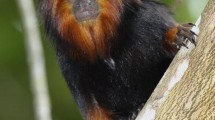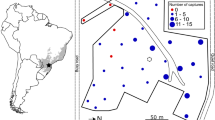Abstract
Many studies on contest competition used residency asymmetry as a discrete variable. However, the probability of winning an interaction may change as a continuous function of the value of the location where the encounter occurs. We performed a field study to examine the importance of location within a home range and relative body size to the outcomes of agonistic interactions between male lizards, Lacerta monticola. The distances to activity centers (the most used locations based on a density function of sightings) and relative size play important roles in agonistic interactions and had interacting effects in natural conditions. On the other hand, previous studies with lizards suggested that inferior competitors are able to avoid agonistic interactions in the field. Thus, we staged encounters in the laboratory to examine the behavioral responses of smaller individuals. The responses of each focal smaller male were measured in its own home cage (resident), in the cage of a larger male (intruder) and in a cage in which no male was previously present (control). The predominant behavioral tactics of smaller males were avoidance when they are the intruders and displaying when they are the residents. Submissive displays by smaller males may help reduce the costs of agonistic encounters.



Similar content being viewed by others
References
Aragón P, López P, Martín J (2001a) Seasonal changes in activity and spatial and social relationships of the Iberian rock lizard, Lacerta monticola. Can J Zool 79:1965–1971
Aragón P, López P, Martín J (2001b) Chemosensory discrimination of familiar and unfamiliar conspecifics by lizards: implications of field spatial relationships between males. Behav Ecol Sociobiol 50:128–133
Aragón P, López P, Martín J (2003) Differential avoidance responses to chemical cues from familiar and unfamiliar conspecifics by male Iberian rock lizards (Lacerta monticola). J Herpetol 37:583–585
Aragón P, López P, Martín J (2004) The ontogeny of spatio-temporal tactics and social relationships of adult male Iberian rock lizards, Lacerta monticola. Ethology 110:1001–1019
Archer J (1987) The behavioural biology of aggression. Cambridge University Press, Cambridge
Baird TA, Timanus DK, Sloan CL (2003) Intra- and intersexual variation in social behavior. In: Fox SF, McCoy JK, Baird TA (eds) Lizard social behavior. Johns Hopkins University Press, Baltimore, pp 7–46
Beaugrand JP, Payette D, Goulet C (1996) Conflict outcome in male green swordtail fish dyads (Xiphophorus helleri): interaction of body size, prior dominance/subordination experience, and prior residency. Behaviour 133:303–319
Beletsky LD, Orians GH (1989) Territoriality among male red-winged blackbirds III. Testing hypotheses of territorial dominance. Behav Ecol Sociobiol 24:333–339
Bradbury WJ, Vehrencamp L (1998) Principles of animal communication. Sinauer, Sunderland, Mass, pp 771–782
Carpenter CC, Ferguson GW (1977) Variation and evolution of stereotyped behaviour in reptiles. In: Gans C, Tinkle DW (eds) Biology of the reptilia, Ecology and behaviour A, vol 7. Academic, London, pp 335–554
Cooper WE (2003) Social behavior and antipredatory defense in lizards. In: Fox SF, McCoy JK, Baird TA (eds) Lizard social behavior. Johns Hopkins University Press, Baltimore, pp 107–141
Cooper WE, Vitt LJ (1987) Deferred agonistic behavior in a long-lived sicincid lizard Eumeces laticeps. Oecologia 72:321–326
Cooper WE, Pérez-Mellado V, Baird TA, Caldwell JP, Vitt LJ (2004) Pursuit deterrent signalling by the bonaire whiptail lizard Cnemidophorus murinus. Behaviour 141:297–311
Dodd CK (1993) The effects of toe-clipping on sprint performance of the lizard Cnemidophorus sexlineatus. J Herpetol 27:209–213
Edsman L (2001) Odours and ownership-scent matching in the territorial wall lizard. In: Vicente L, Crespo EG (eds) Mediterranean Basin lacertid lizards. A biological approach. Proceedings of the 2nd international symposium on the lacertids of the Mediterranean Basin. Instituto da Conservaçao da Naturaleza, Lisboa, Portugal, pp 133
Elvira B, Vigal CR (1985) Further data on the reproduction of Lacerta monticola cyreni (Sauria, Lacertidae) in Central Spain. Amphibia-Reptilia 6:173–179
Enquist M, Leimar O (1983) Evolution of fighting behaviour: decision rules and assessment of relative strength. J Theor Biol 102:387–410
de Fraipont M, Clobert J, John-Alder H, Meylan S (2000) Increase pre-natal maternal corticosterone promotes philopatry of offspring in common lizards Lacerta vivipara. J Anim Ecol 69:404–413
Gosling LM, McKay HV (1990) Competitor assessment by scent matching: an experimental test. Behav Ecol Sociobiol 26:415–420
Hammerstein P, Riechert SE (1988) Payoff and strategies in territorial contests: ESS analyses of two ecotypes in the spider, Agelenopsis aperta. Evol Ecol 2:115–138
Husak JF, Fox SF (2003) Adult male collared lizards, Crotaphytus collaris, increase aggression towards displaced neighbours. Anim Behav 65:391–396
Johnsson JI, Forser A (2002) Residence duration influences the outcome of territorial conflicts in brown trout (Salmo trutta). Behav Ecol Sociobiol 51:282–286
Keltner D, Potegal M (1997) Appeasement and reconciliation: introduction to an aggressive behavior special issue. Aggr Behav 23:309–314
Larkin RP, Halkin D (1994) A review of software packages for estimating animal home ranges. Wildl Soc Bull 22:274–287
Littell RC, Millinken GA, Stroup WW, Wolfinger RD (1996) SAS systems for mixed models SAS Institute. Cary, North Carolina
López P, Martín J (2001) Fighting rules and rival recognition reduce costs of aggression in male lizards, Podarcis hispanica. Behav Ecol Sociobiol 49:111–116
López P, Martín J, Barbosa A (2000) Site familiarity affects antipredatory behavior of the amphisbaenian Blanus cinereus. Can J Zool 78:2142–2146
López P, Aragón P, Martín J (2003) Responses of female lizards, Lacerta monticola, to males' chemical cues reflect their mating preference for older males. Behav Ecol Sociobiol 55:73–79
Luque-Larena JJ, López P, Gosalvez J (2001) Scent matching modulates space use and agonistic behaviour between male snow voles Chionomys nivalis. Anim Behav 62:1089–1095
Martín J, López P, Cooper WE, Jr (2003) Loss of mating opportunities influences refuge use in the Iberian rock lizard, Lacerta monticola. Behav Ecol Sociobiol 54:505–510
Martins EP, Lacy KE (2004) Complex behavior and ecology of rock iguanas. I. Evidence for an appeasement display. In: Alberts A, Carter R, Hayes W, Martins E (eds) Iguanas: biology and conservation. University of California Press, pp 101–108
Maynard Smith J (1982) Evolution and the theory of games. Cambridge University Press, Cambridge
Maynard-Smith J, Parker GA (1976) The logic of asymmetrical contests. Anim Behav 32:564–578
McMann S (2000) Effects of residence time on displays during territory establishment in a lizard. Anim Behav 59:513–522
McMann S, Paterson AV (2003) The relationship between location and displays in a territorial lizard. J Herpetol 37:414–416
Melemis SM, Falls JB (1982) The defense function: a measure of territorial behavior. Can J Zool 60:495–501
Moreia PL, Birkhead TR (2004) Copulatory plug displacement and prolonged copulation in the Iberian rock-lizard (Lacerta monticola). Behav Ecol Sociobiol 56:290–297
Olsson M (1992) Contest success in relation to size and residency in male sand lizards, Lacerta agilis. Anim Behav 44:386–388
Ott JA, Scott DE (1999) The effects of toe clipping and PIT-tagging on growth and survival in metamorphic Ambystoma opacum. J Herpetol 33:344–348
Parker GA (1974) Assessment strategy and the evolution of fighting behaviour. J Theor Biol 47:223–243
Quinn GP, Keough MJ (2002) Experimental design and data analysis for biologists. Cambridge University Press, Cambridge
Rice WR (1989) Analysing tables of statistical test. Evolution 43:223–225
Riechert SE (1998) Game theory and animal contests. In: Dugatkin LA, Reeve HK (eds) Game theory and animal behavior. Oxford University Press, Oxford, pp 64–93
Rose B (1982) Lizard home ranges: methodology and function. J Herpetol 16:253–269
Sandell M, Smith HG (1991) Dominance, prior occupancy, and winter residency in the great tit (Parus major). Behav Ecol Sociobiol 29:147–152
SAS Institute (1999) SAS/STAT user's guide version 8. SAS Institute, Cary, NC
Shanas U, Terkel J (1997) Mole-rat harderian gland secretions inhibit aggression. Anim Behav 54:1255–1263
Shutler D, Weatherhead PJ (1992) Surplus territory contenders in male red-winged blackbirds: where are the desperados? Behav Ecol Sociobiol 31:97–106
Shutler D, Weatherhead PJ (1994) Movement patterns and territory acquisition by male red-winged blackbirds. Can J Zool 72:712–720
Simpson BS (1985) Effects of location in territory and distance from neighbours on the use of song repertories by Carolina wrens. Anim Behav 33:793–804
Slotow R (1996) Aggression in white-crowned sparrows: effects of distance from cover and group size. Condor 98:245–252
Stamps JA (1995) Motor learning and the value of familiar space. Am Nat 146:41–58
Stamps JA, Krishnan VV (1994) Territory acquisition in lizards: I. First encounters. Anim Behav 47:1375–1385
de Waal FBM (1986) The integration of dominance and social bonding in primates. Q Rev Biol 61:459–479
Wolfinger RD (1993) Covariance structure selection in general mixed models. Commun Stat-Simul C 22:1079–1106
Worton BJ (1989) Kernel methods for estimating the utilisation distribution in home range studies. Ecology 70:164–168
Acknowledgements
We thank William E. Cooper, Jr. and three anonymous reviewers for constructive and helpful comments, and “El Ventorrillo” Field Station for the use of their facilities. Financial support was provided by the project MCYT BOS2002-00598 from Spanish Ministerio de Ciencia y Tecnologia. The experiments were performed with license from the Agencia del Medio Ambiente de la Comunidad de Madrid (Spain).
Author information
Authors and Affiliations
Corresponding author
Additional information
Communicated by W. E. Cooper
Rights and permissions
About this article
Cite this article
Aragón, P., López, P. & Martín, J. Roles of male residence and relative size in the social behavior of Iberian rock lizards, Lacerta monticola . Behav Ecol Sociobiol 59, 762–769 (2006). https://doi.org/10.1007/s00265-005-0106-8
Received:
Revised:
Accepted:
Published:
Issue Date:
DOI: https://doi.org/10.1007/s00265-005-0106-8




